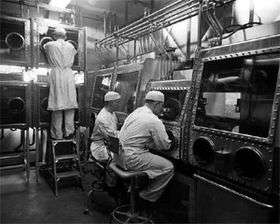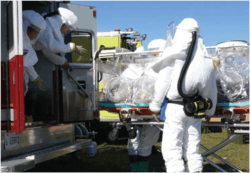Biocontainment

The concept of biocontainment is related to laboratory biosafety[1] and pertains to microbiology laboratories in which the physical containment of highly pathogenic organisms or agents (bacteria, viruses, and toxins) is required, usually by isolation in environmentally and biologically secure cabinets or rooms, to prevent accidental infection of workers or release into the surrounding community during scientific research. The term "biocontainment" was coined in 1985,[2] but the concept stretches back at least to the 1940s.
Containment types
Primary containment is the first container in direct contact with biohazardous material[3] as well as protection of personnel and the immediate laboratory environment from exposure to infectious agents. Primary containment requires using proper storage containers, good microbiological technique, and the use of appropriate safety equipment such as biological safety cabinets.
Secondary containment is the protection of the environment external to the laboratory from exposure to infectious materials and is provided by a combination of facility design and operational practices.
Biological safety cabinets (BSC), first commercially available in 1950,[4] are fairly common devices designed to provide effective primary biocontainment in laboratories working with highly infectious agents. Three general levels and types have been devised (Class I, Class II, and Class III).
Biosafety suites are suites of laboratory rooms which are essentially equivalent to large Class III cabinets in which positive pressure personnel suits ("space suits") serve as the "outside" environment for workers. Examples include the biosafety suites at USAMRIID at Fort Detrick, Maryland, USA and the Maximum Containment Facility (MCF) of the CDC in Atlanta, Georgia, USA.
Agricultural containment: The term “biocontainment” is used differently in facilities for the study of human pathogens versus those used for the study of agricultural pathogens. In agricultural facilities, the definition for “biocontainment” resembles that for “biosafety,” i.e., the safety practices and procedures used to prevent unintended infection of plants or animals or the release of high-consequence pathogenic agents into the environment (air, soil, or water). In the agricultural setting, worker protection and public health are always considerations; however, emphasis is placed on reducing the risk that agents under study could escape into the environment.
Biosafety levels
A "biosafety level" (BSL) is the level of the biocontainment precautions required to isolate dangerous biological agents in an enclosed laboratory facility. The levels of containment range from the lowest biosafety level 1 (BSL-1) to the highest at level 4 (BSL-4). In the United States, the Centers for Disease Control and Prevention (CDC) have specified these levels.[5] In the European Union, the same biosafety levels are defined in a directive.[6]
Guidelines

Today, guiding publications for biosafety and containment in the US are set by the Centers for Disease Control and Prevention (CDC) and the National Institutes of Health (NIH).[7] Since 1984, the CDC and the NIH have jointly authored the Biosafety in Microbiological and Medical Laboratories (BMBL) and the separately-published section of the BMBL, Appendix A: "Primary Containment for Biohazards: Selection, Installation, and Use of Biosafety Cabinets". The BMBL sets national regulations for Biosafety Levels, Containment, Decontamination and Disinfection, Transportation, and Disposal of biohazardous agents.
See also
- Aeromedical Isolation Team
- Biosafety
- Biosafety level
- Biosecurity
- Biological hazard
- Safety engineering
- Security engineering
- Select agent
References
Citations
- ↑ Public Health Emergency Website, US Dept of Health & Human Services Archived April 13, 2012, at the Wayback Machine.
- ↑ "Biocontainment”, Merriam Webster Online
- ↑ Definition of primary containment
- ↑ Wedum, A.G. (1969), "The Detrick experience as a guide to the probable efficacy of P4 microbiological containment facilities for studies on microbial recombinant DNA molecules"; J Am Biol Safety Assoc;1:7-25.
- ↑ Richmond JY, McKinney RW (editors) (1999). Biosafety in Microbiological and Biomedical Laboratories (4th ed.). ISBN 0-7881-8513-6.
- ↑ Council Directive 90/679/EEC of 26 November 1990 on the protection of workers from risks related to exposure to biological agents at work, OJ No. L 374, p. 1.
- ↑ CDC Biosafety
Also:
- Biosafety in Microbiological and Biomedical Laboratories (1999), 4th Edition, U.S. Department of Health and Human Services, Public Health Service, Centers for Disease Control and Prevention, National Institutes of Health, Washington, DC: U.S. Government Printing Office.
- The 2013 International Conference on Biocontainment Facilities
- The 2014 International Conference on Biocontainment Facilities
- eBook Reference: Management Principles for Building and Operating Biocontainment Facilities (Kindle Edition)
- Wedum, A.G., W.E. Barkley, and A. Hellman (1972), "Handling of infectious agents", Journal of the American Veterinary Medical Association, 161(11):1557-1567.